(December 1954 – June 1955: Young Romance #75 – #77, Young Love #63 – #65, Young Brides #20 – #22, In Love #3 – #5)
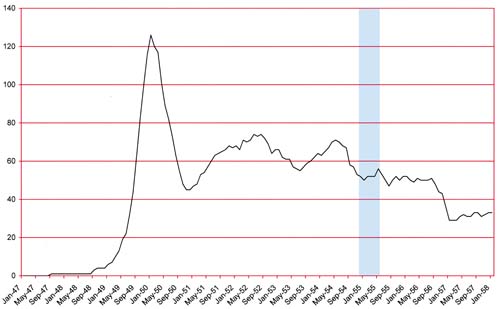
Number of Romance titles 1947 – 1958 (the period covered in this chapter is shaded in blue)
Comic book publishers were in trouble. One indication of this is the number of romance titles had reached a low point. This had happened a couple times before but previously there was a recovery, however not this time. While the number of romance titles will plateau for a while the number of romance comic publishers would continue to decline (The Real Reason for the Decline of Comics).
Simon and Kirby might not have noticed the trouble in the industry before but they could hardly miss it now. Young Romance and Young Love, two of the titles that Joe and Jack produced for Prize, had been monthlies for many years but with the December issues became bimonthlies. Something very odd happened with the February releases, there were none. Both Young Romance and Young Love should have come out that month but would only reappear in April (their next schedule date). In “The Comic Book Makers” Joe remarks on some problems that developed when the owners of Prize noticed that Simon and Kirby had recycled old art. Perhaps this is the explanation for the lost February. (So far I have not identified this reused art but this is not surprising considering the thousands of pages of romance art that Simon and Kirby produced. But there was Fighting American story from this time period that was based on an old Manhunter story (Fighting American, Jumping the Shark). In his book Joe mentions a November 1954 meeting that came about due to this problem. Add a couple of months (because comic cover dates are advanced) and that would be January very near the lost February.
Joe and Jack were also publishing their own comics but there were no lost months for their In Love. However In Love #4 (March 1955) would be the last issue Simon and Kirby would publish themselves. Their distributor, Leader News, was particularly hit by a public backlash against comics. With the failure of Leader News, Simon and Kirby would turn to Charlton to publish their titles. Charlton was notorious for their low pay scale so I suspect that whatever deal they made with Joe and Jack was not that great.
In this serial post I like to provide the line up of the artists based on their productivity. During the period covered in this chapter that would be Bill Draut (61 pages), Jo Albistur (31 pages), Bob McCarty (26 pages), Ann Brewster (25 pages), Jack Kirby (19 pages), John Prentice (11 pages), Ross Andru (12 pages), Leonard Starr (4 pages), Art Gates (3 pages) and Mort Meskin (2 pages). I will comment on most of these artists below. However this list is very incomplete as there are a number of artists that I have not been able to identify. While the individual contributions of these unidentified artists were not great, combined they provided 107 pages of art.
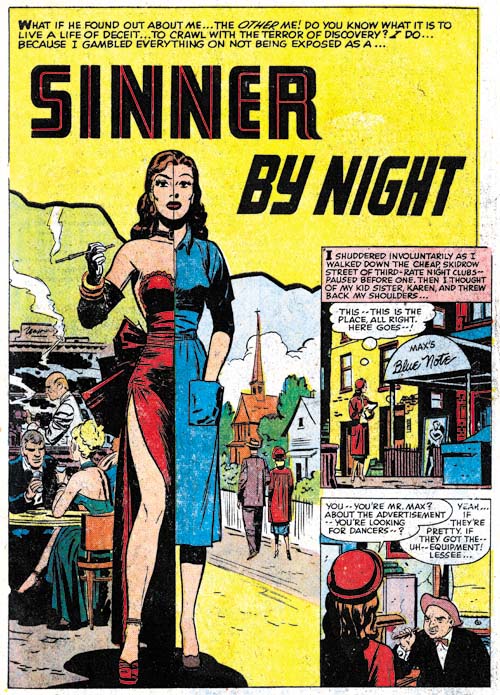
Young Brides #20 (December 1954) “Sinner by Night”, art by Bill Draut
Bill Draut was not only the most productive romance artists during this period he was the most important one in other ways as well. Bill did 8 of the 9 lead stories for the Prize titles. He also provided 6 covers for Prize and 1 for In Love. All these covers appear to be created by Bill specifically for the cover and were not recycled art from a story splash as recently was often the case.

Young Love #63 (December 1954) “Another Love”, art by Bill Draut
Draut was a real work horse of the Simon and Kirby studio. While not as prolific as Jack Kirby or Mort Meskin, it seems Simon and Kirby could always count on Bill to provide great art. But there is something very unusual about “Another Love”. It starts out in a typical Draut manner but the following pages look different. The characters all look like they were drawn by Draut but the way the story is graphically told does not look like his.
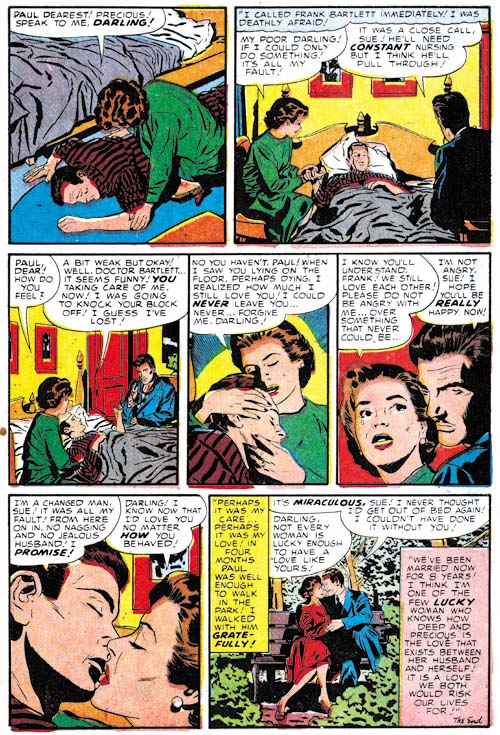
Young Love #63 (December 1954) “Another Love” page 6, pencils by unidentified artist
The last page of “Another Love” provides the answer. Panels 4 to 6 do not look like Draut’s pencil at all. It would appear that this story was drawn, or at least laid out, by another artist. Draut’s inking through most of the story helps hide this fact but either he did not ink the last page or did so with less deviation from the original pencils. Some experts have claimed that Simon and Kirby provided Draut with layouts, at least on occasion. However I have found no evidence to support that claim. This is the first example that I have seen of Draut working on art provided by another artist, although in this case it is not Kirby. Bill Draut was not a naturally prolific artist and I suspect that his recent workload caused him to turn to another artist for help. “Another Love” is the only story from this period that this seemed to be the case; all others look like Draut’s work alone.
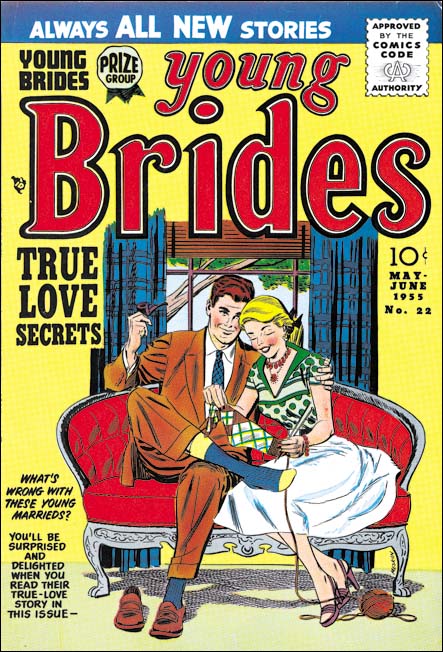
Young Brides #22 (May 1955), art by Mort Meskin
In terms of numbers Mort Meskin’s contribution to this period was pretty meager two pages. Meskin’s period of work for Simon and Kirby is drawing to an end as he increasingly depends on working for DC. It is clear, however, that Simon and Kirby still valued Meskin’s contribution as both pages were covers.
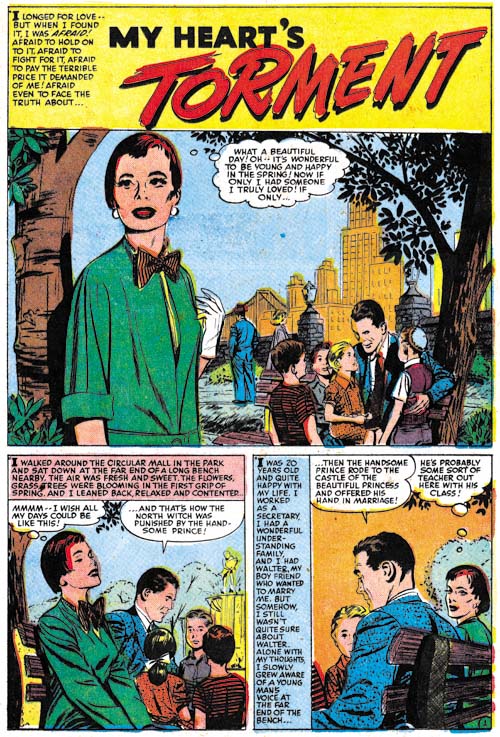
Young Brides #20 (December 1954) “My Heart’s Torment”, art by John Prentice
John Prentice’s contribution was rather meager during this period (11 pages and no covers). Prentice was normally an active presence in Simon and Kirby’s romance comics and his contribution during the period covered by the last chapter was significant. I have no explanation for his relative absence now. “My Heart’s Torment is a rather nice story and although it may not be obvious at a glance the splash panel is actually part of the story. This format was very commonly used by all artists about a year earlier but almost completely abandoned since. Prentice seems to be the last artist who would sometime use this technique.
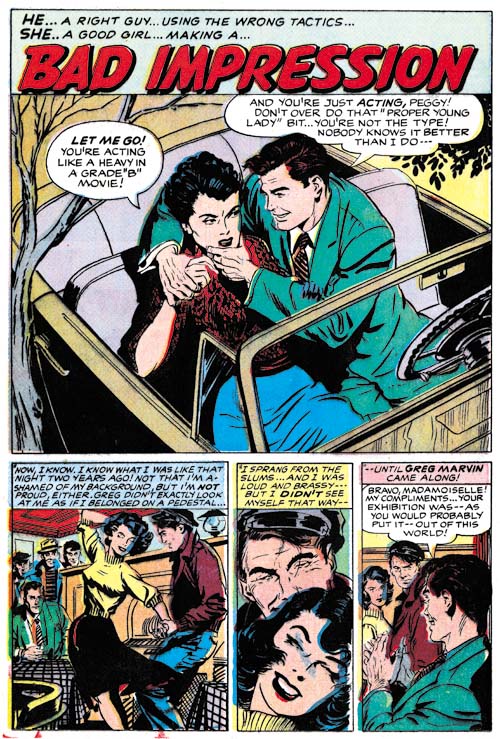
Young Brides #21 (March 1955) “Bad Impression”, art by Bob McCarty
In the past I have often confused Bob McCarty’s work from this period with that by John Prentice. McCarty style is much easier to distinguish in both earlier and later periods but for a while his style look liked Prentice’s. I suspect that this was due to both artists being influenced by Alex Raymond’s Rip Kirby syndication strip. The easiest way to distinguish the two is that McCarty’s men have larger eyes and faces that are not quite so long. While Bob was absent from the previous period his productivity exceeds Prentice during the current one (26 pages).
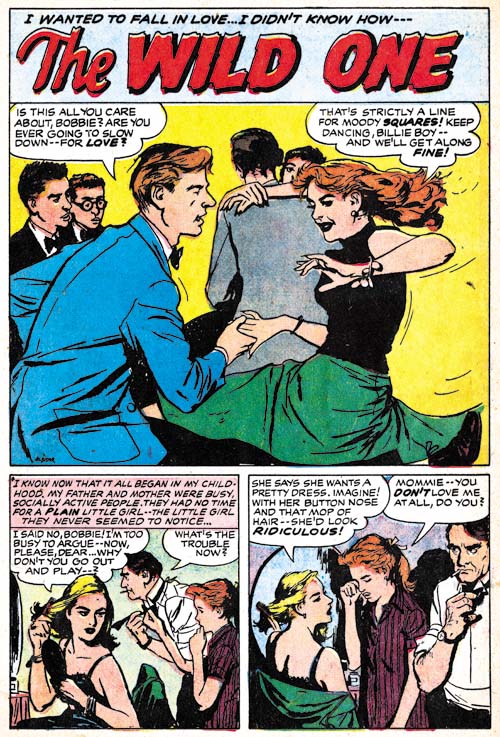
Young Love #65 (June 1955) “The Wild One”, art by Jo Albistur
Jo Albistur was a recent contributor to the Simon and Kirby productions. Jo was from Argentina and would only work for Joe and Jack for about a year. He did some other comic book work but not a lot. Ger Apeldoorn has sent me scans of a cartoon that Albistur did for Humorama. I do not include it her because they are stylistically far removed from his comic book work and I prefer to keep my blog at a GP level and the Humorama pieces are decidedly rated R. While only a relatively newcomer, Albistur provided a substantial amount of art for this period (31 pages). While Albistur is not very well known he is one of my favorite romance artists.
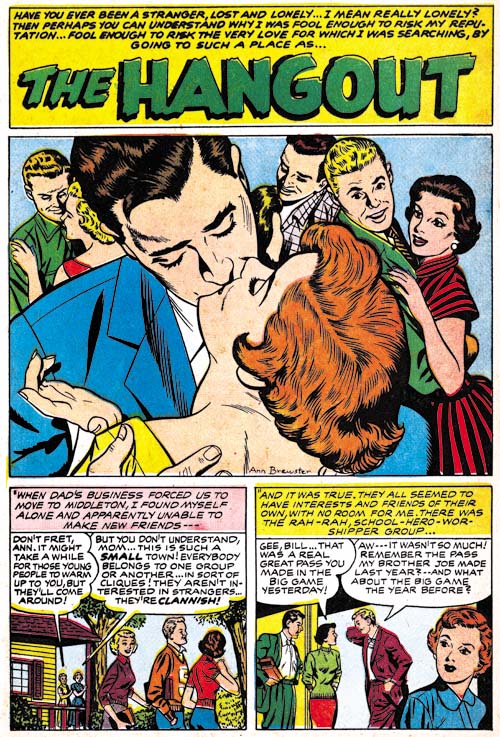
Young Romance #77 (June 1955) “The Hangout”, art by Ann Brewster
Ann Brewster was another recent but much used artists. Some years ago she had done a little work for Simon and Kirby (Art of Romance, Chapter 9). Ann is another of my favorites and Simon and Kirby were obviously impressed by her as well. In fact she was one of the small group of artists who provided cover art for the Prize romance comics while Kirby was busy taking care of business (the other cover artists were Bill Draut, Mort Meskin, John Prentice and Bob McCarty). However Brewster’s covers art was not originally created for that purpose but rather derived from the splash from her story art. Simon and Kirby had converted splash art into covers before. It is the sort of thing Joe Simon would do in the future so I suspect he rather than Jack was behind these efforts.
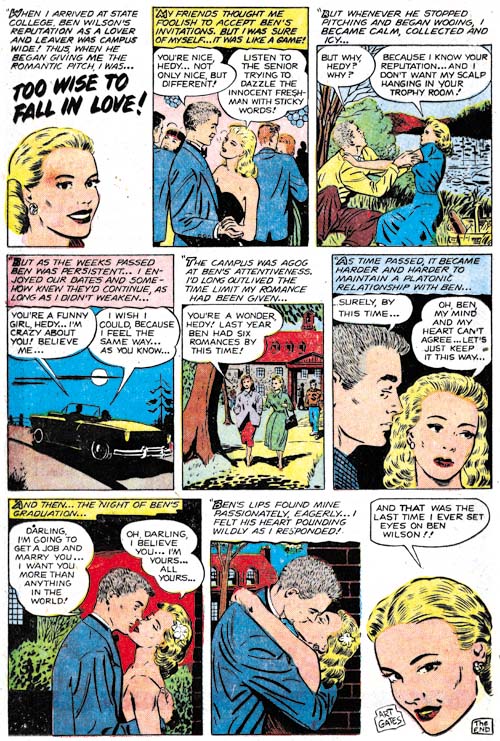
Young Romance #75 (December 1954) “Too Wise to fall in Love”, art by Art Gates
Art Gates has returned to providing only single page pieces and not many of them either (3 pages). But such single page works seemed to have been a specialty of Gates. Art could provide either cartoons or more realistic art but there seemed no place for his gag cartoons in the Simon and Kirby romance comics.
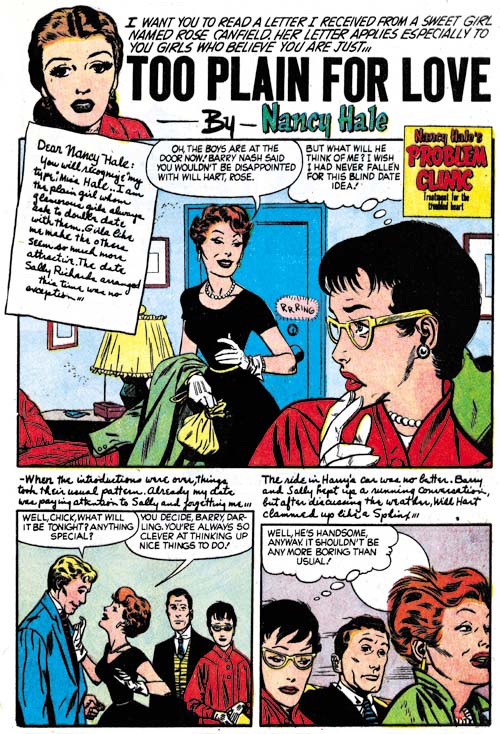
Young Romance #75 (December 1954) “Too Plain for Love”, pencils by Ross Andru
There are two stories (12 pages) by Ross Andru during this period. As I mentioned in the last chapter, these stories by Andru were almost certainly obtained from left over work when Mikeross publishing failed (the publishing company owned by Mike Esposito and Andru Ross). “Too Plain for Love” was converted into a Nancy Hale story but it is not clear if there were any modifications beyond the title added to the top of the splash page. The story is very unusual in have the captions written in a cursive script.
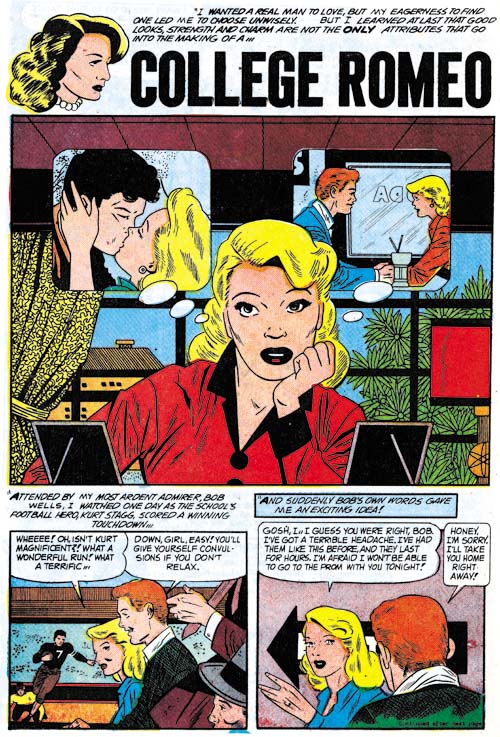
Young Love #63 (December 1954) “College Romeo”, art by unidentified artist and Ross Andru
The lady in the splash in “College Romeo” also appears to be drawn by Ross Andru. The rest of the art, however, was clearly done by another, less talented, artist. I suspect this is another worked picked up from the failed Mikeross publishing. The panel layout for the splash page is the same as that used by the stories that were completely done by Andru but this is not too significant because this was a commonly used formula.

Young Love #63 (December 1954) “Lovely Liar”, art by unidentified artist
As I mentioned at the start of this post, there were quite a few artists working for Simon and Kirby during this period that I have not been able to identify. I will not be discussing them all but I thought I would provide a few examples.
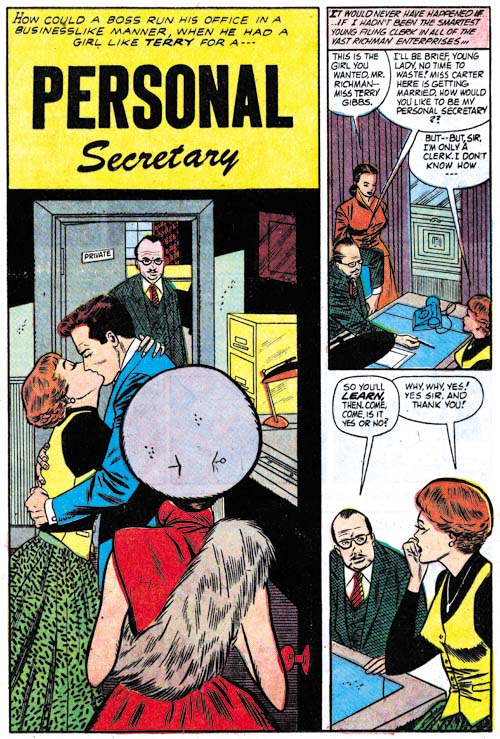
Young Romance #75 (December 1954) “Personal “Secretary”, art by unidentified artist
The artist for “Personal Secretary” might have been the same one who did the previous example, “Lovely Liar”.
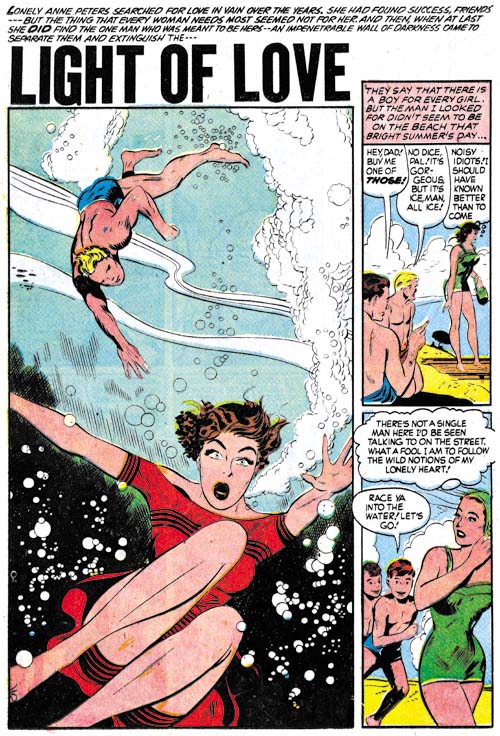
Young Romance #75 (December 1954) “Light of Love”, art by unidentified artist
The woman in the splash panel of “Light of Love” was done in a style somewhat like that of Ross Andru. I am not, however, convinced that Andru actually worked on this piece and it maybe nothing more then the actual penciler being influenced by Andru. Note the panel layout common to this page and the two previous examples. While a vertical splash panel is not that unusual in Simon and Kirby productions, that combined with tall narrow story panels is. Nor is this format found in any of the stories drawn by Ross Andru. I am sure that these pieces were picked up from a failed comic book title but perhaps from a publisher other than Mikeross.
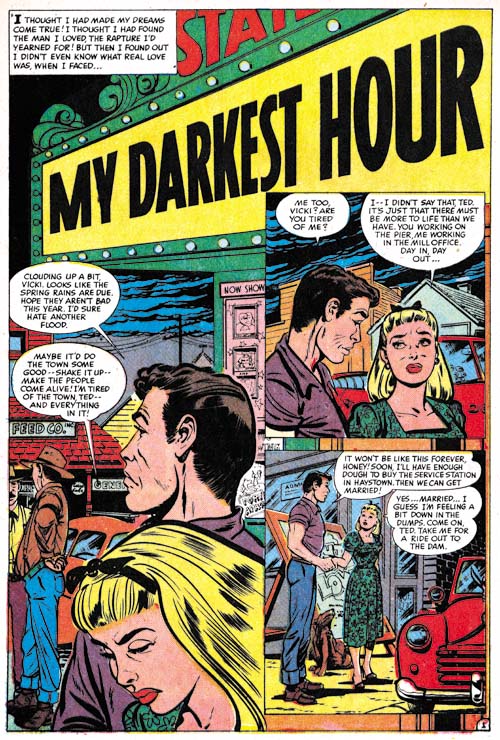
Young Brides #20 (December 1954) “My Darkest Hour”, art by unidentified artist
Parts of “My Darkest Hour” remind me of the work of Bob Powell but not enough to convince me he actually drew the piece. I remember it has been said that he employed artists to help with his work load. Perhaps this is a case of a studio hand producing a Powell imitation. Note the rather nice touch of placing the story title in the theater marquee.
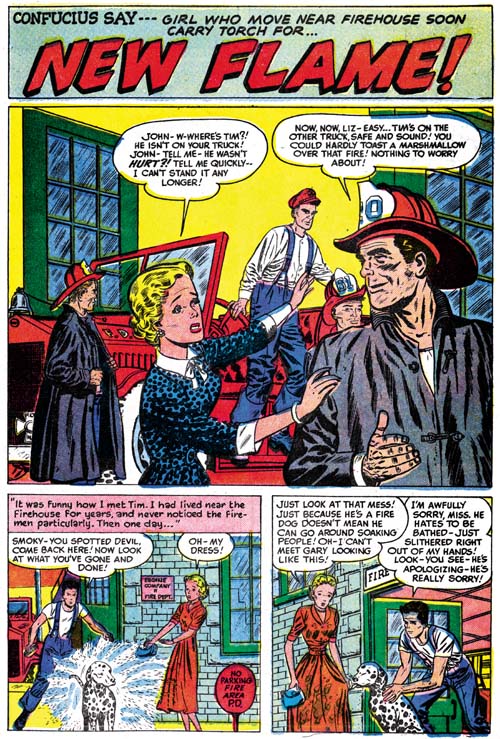
In Love #5 (May 1955) “New Flame”, art by unidentified artist
Artists new to Simon and Kirby romance productions were not limited to the Prize titles but appeared in their own In Love as well. The first three issues of In Love included a very long story that left room only for a single backup story and some single page pieces. However use of a long story was dropped with In Love #4. This allowed for a greater number of artists to appear. Some of the artists such as Bill Draut, Bob McCarty and Art Gates appeared in the Prize titles as well. One artist, Leonard Starr, had worked for Simon and Kirby in the past but only infrequently in recent times. And yes there are artists that I have not yet identified.
Each publisher tended to have his own house style. While “New Flame” is not too different from the typical Simon and Kirby story it reminds me much more of work that appeared in the Harvey romance comics. In fact the use of lower case letters in captions was typical of one of the letters employed by Harvey. The use by Simon and Kirby of art that originally was meant for Harvey occurred previously (Art of Romance, Chapter 13) but that was during the romance glut. During the glut Harvey cancelled some romance titles and put other on hold. Therefore it seems reasonable that Harvey might have wanted to unload some of his art. But while Harvey probably suffered decreased sales during this period, I do not believe he cancelled any titles. So was this really Harvey art? And if so, how did Simon and Kirby get a hold of it?
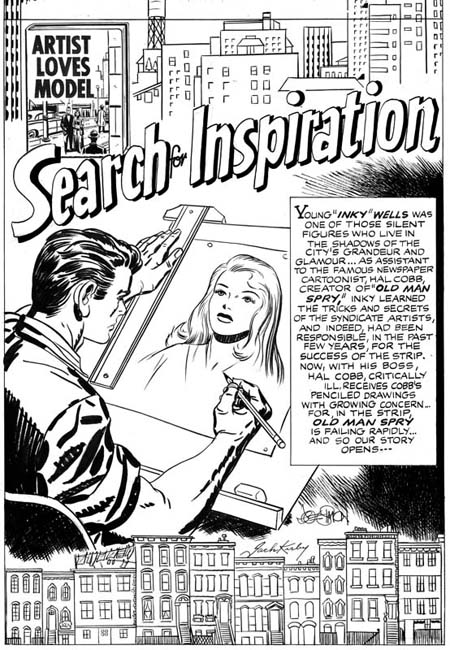
In Love #3 (January 1955) “Search for Inspiration” (original art), pencils by Jack Kirby, inks by Joe Simon
I have previously written on Jack Kirby’s contribution to In Love #3 (In Love #3 and Artist Loves Model). While Kirby’s piece for In Love #3 was a long one most of it was recycled art from a failed syndication attempt. This relative absence of Kirby from even his and Joe’s Mainline comics suggests that Jack was more involved in business matters then he previously had been.
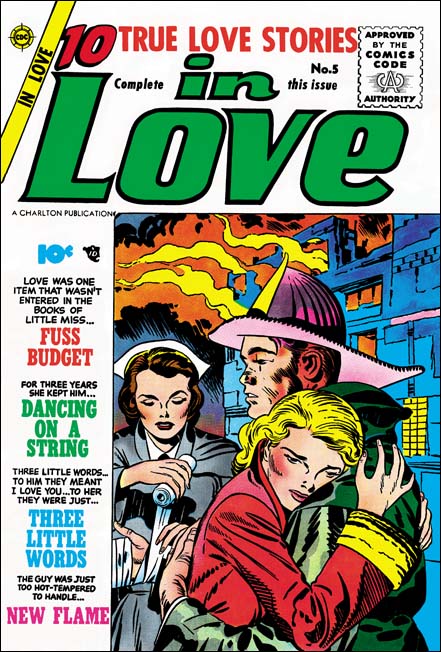
In Love #5 (May 1955), art by Jack Kirby
As mentioned earlier, Simon and Kirby’s own publishing company, Mainline, failed due to financial difficulties that the distributor Leader News encountered during a public backlash at comic books. Joe and Jack made a deal with Charlton comic to publish the Mainline titles including In Love. The fifth issue was the first Charlton published one and it featured a beautiful Kirby drawn and inked cover. The original art still exists but has the title Exciting Romances. Apparently Simon and Kirby were using it as portfolio piece to show perspective publishers.
If nothing else it makes a nice end to a chapter for a period with very little Kirby art.
Chapter 1, A New Genre (YR #1 – #4)
Chapter 2, Early Artists (YR #1 – #4)
Chapter 3, The Field No Longer Their’s Alone (YR #5 – #8)
Chapter 4, An Explosion of Romance (YR #9 – #12, YL #1 – #4)
Chapter 5, New Talent (YR #9 – 12, YL #1 – #4)
Chapter 6, Love on the Range (RWR #1 – #7, WL #1 – #6)
Chapter 7, More Love on the Range (RWR #1 – #7, WL #1 – #6)
Chapter 8, Kirby on the Range? (RWR #1 – #7, WL #1 – #6)
Chapter 9, More Romance (YR #13 – #16, YL #5 – #6)
Chapter 10, The Peak of the Love Glut (YR #17 – #20, YL #7 – #8)
Chapter 11, After the Glut (YR #21 – #23, YL #9 – #10)
Chapter 12, A Smaller Studio (YR #24 – #26, YL #12 – #14)
Chapter 13, Romance Bottoms Out (YR #27 – #29, YL #15 – #17)
Chapter 14, The Third Suspect (YR #30 – #32, YL #18 – #20)
Chapter 15, The Action of Romance (YR #33 – #35, YL #21 – #23)
Chapter 16, Someone Old and Someone New (YR #36 – #38, YL #24 – #26)
Chapter 17, The Assistant (YR #39 – #41, YL #27 – #29)
Chapter 18, Meskin Takes Over (YR #42 – #44, YL #30 – #32)
Chapter 19, More Artists (YR #45 – #47, YL #33 – #35)
Chapter 20, Romance Still Matters (YR #48 – #50, YL #36 – #38, YB #1)
Chapter 21, Roussos Messes Up (YR #51 – #53, YL #39 – #41, YB #2 – 3)
Chapter 22, He’s the Man (YR #54 – #56, YL #42 – #44, YB #4)
Chapter 23, New Ways of Doing Things (YR #57 – #59, YL #45 – #47, YB #5 – #6)
Chapter 24, A New Artist (YR #60 – #62, YL #48 – #50, YB #7 – #8)
Chapter 25, More New Faces (YR #63 – #65, YLe #51 – #53, YB #9 – #11)
Chapter 26, Goodbye Jack (YR #66 – #68, YL #54 – #56, YB #12 – #14)
Chapter 27, The Return of Mort (YR #69 – #71, YL #57 – #59, YB #15 – #17)
Chapter 28, A Glut of Artists (YR #72 – #74, YL #60 – #62, YB #18 & #19, IL #1 & #2)
Chapter 29, Trouble Begins (YR #75 – #77, YL #63 – #65, YB #20 – #22, IL #3 – #5)
Chapter 30, Transition (YR #78 – #80, YL #66 – #68, YBs #23 – #25, IL #6, ILY #7)
Chapter 30, Appendix (YB #23)
Chapter 31, Kirby, Kirby and More Kirby (YR #81 – #82, YL #69 – #70, YB #26 – #27)
Chapter 32, The Kirby Beat Goes On (YR #83 – #84, YL #71 – #72, YB #28 – #29)
Chapter 33, End of an Era (YR #85 – #87, YL #73, YB #30, AFL #1)
Chapter 34, A New Prize Title (YR #88 – #91, AFL #2 – #5, PL #1 – #2)
Chapter 35, Settling In ( YR #92 – #94, AFL #6 – #8, PL #3 – #5)
Appendix, J.O. Is Joe Orlando
Chapter 36, More Kirby (YR #95 – #97, AFL #9 – #11, PL #6 – #8)
Chapter 37, Some Surprises (YR #98 – #100, AFL #12 – #14, PL #9 – #11)
Chapter 38, All Things Must End (YR #101 – #103, AFL #15 – #17, PL #12 – #14)


The “College Romeo” story could have been penciled by Pete Morisi who drew DYNAMITE as well as the later Charlton titles THUNDERBOLT and VENGENCE SQUAD (as well as mannnnnyyyy anthology stories at Charlton for years). It looks like his brand of George Tuska influenced art.
Chance Fiveash
The art on College Romeo” reminds me of Pete Morisi.
I haven’t seen you mention him in association with Simon and Kirby, but he was active during that era.
Finally a post I can attribute something to. I am still reading every post and they are a great start of the weekend for me.
The unidentified artist of Collega Love almost certainly is Pete Morisi. As I now see, the previous poster also says. And he most certainly is not a lesser artist (although Ross Andru is a huge talent on his own). He is a very mannered artist, though and his manarisms may sometimes come across as stiffness. But his storytelling is impeccable and his style can be mesmerizing. I will put up a couple of his lesser know earlier western stories on my blog (www.allthingsger.blogspot.com) where his unique style creates a wonderful world. But if you follow the tag there, you’ll also see a later sf piece with superb story composition. Morisi worked all over the place in the fifties, so it’s not surprising to find him at simon and Kirby as well (or at Mikeross, if they were the original suppliers. Which makes me think… was the use of Mikeross material the reason for the februari suspension?
As for the others…
Lovely Liar has that Mikeross look as well. In an interview in Alter Ego Martin Rosenthall (who signed his work Thall) said he was the one who sold on the surplus love material. He inked a lot of Andru material, but he was an artist in his own right in a totally differnt style. among the Mikeross stories in the Prize books are some that look like hastily drawn Andru stories with Thall finishing/inking. He had become a partner of Esposito and Andru and sold the leftover material to get some of his money back. This story looks like one of those… but without the obvious Andru faces. Is it a Thall story? Or could it be by Artie Saaf, who also worked for Mikeross in a Andru/Toth derived style. The Personal Secretary certainly is a candidate for Artie Saaf. Saaf’s son is on the Yahoo Timely group. He might be able to see.
The left hand splash panel is an indication of Mikeross. Or eh… it was used heavely by Ross Andru, Mike Sekowsky, Bill Walton, Alex Toth, Artie Saaf and others at Standard, a habit they took along to their subsequent jobs at Timely/Atlas.
I took one look at My Darkest Hour and thought Powell. It’s there in the faces, but also in the posture of the man in the blue jeans. And I think Powell had disbanded his studio at that point. Maybe it’s just a case of him holdong back his more outrageous lay-outs.
The New Flame seems like the work of Lee Elias to me. For some reason his romance work was always a lot more restrained than his sf or horror work (or his humor work, for that matter). But he is there quite obviously for me in the face of the woman in the splash.
And finally, what struck me most in Another Love, is the ruler inked paintings and buildings. Something Draut rarely did, I think. Makes the whole thing seem like a salvaged job, started by someone, but finished by someone else.
Oh and John Prentice got loads of work from DC at this time. They exstanded their ‘horror’ line and started introducing new artists while letting them work in their own style. Prentice, Starr, McCarthy, Meskin, Drucker, Ely, Elias, Roussos, Eadeh. Some worked hard to improve their style (such as Meskin and Eadeh) and some just did oads of stories (such as Prentice, who even got covers).
Three of you have identified Pete Morisi as the artist for “College Romeo”. Well that certainly lead me to check out his work at Ger’s great site and Atlas Tales. Spot on. I am migrating to a new computer and my database is not up but I do not remember having entered anything signed by Morisi. But Ger I still stand by my comment, Morisi may be interesting but he is much less talented than Andru. Romance art is often the acid test of how good an artist is. You can hide alot in things like war, crime and westerns (such as those great landscapes in the recent post by Ger) but romance has much less to fall back other than the graphically telling of the story itself. Morisi simply does not have anything near Andru’s range.
It is not the vertical splash but the tall narrow story panels that make these stories so unusual. I have never seen anything like them in the Mikeross comics. But if they do occur in Standards than that might be the source for this set of stories. The timing is certainly right in that Standard had about 4 romance comics but fell victim to the comic crisis with the last one having an August 1954 cover date.
While Bill Draut did not use a ruler for brickwork, he did use one all the time for doorways, windows, etc. It is the way that the point of view is used, and other techniques of graphically telling the story that impress me. They seem so different from Draut’s normal techniques that I am sure that someone else had at least laid out the story.
It was the inset panels with rounded corners which more than anything made me think of Morisi.
There is an exceptional interview with Morisi in issue #12 of Comic Book Artist.
The Morisi interview is spread over two issues of Comic Book Artist. The first part is in issue #9.
When asked what attracted him to comics Morisi says, “In one word. Kirby.”
I notice Ger has posted some stories by Morisi over at his blog as promised.
Ger notes that some people confuse Morisi and George Tuska.
Here’s what Morisi said about Tuska in CBA #9.
PAM: “I grew up enjoying Tuska’s art. When the time came for me to step into comics, I thought it was only fair to ask permission to work in his style. I asked, and he said, “Okay.” That was it.”
Of the other stories; the art on Lovely Liar, and Personal Secretary looks like Gil Kane.
Why is that Pat? Atlas Tales has a Kane story which looks very different from “Lovely Liar” and “Personal Secretary”. Granted it is a different genre but can you point to any work by Kane that is closer?
Harry, Is the Atlas Tales story as early as 1954? Kane said in an interview there was a point in the 50’s where he became dissatisfied with his work, and undertook an intensive period of study.
The splash panel of Lovely Liar in particular looks like Kane to me.
More than anything it’s the head of the woman in the splash panel.
The angularity of the woman’s head, her mouth, and hair, the folds in the man’s jacket, the profile of the woman’s head in panel two, the woman again in panel three, all remind me of Kane.
I have no particular reason to believe it is Kane’s work, it’s just an impression.
I do have several Rex the Wonder Dog comics stories by Kane from a few years later, and they are head and shoulders better than what we are looking at here.
Harry, I checked the Kane story at Atlas tales. It’s a year earlier than the romance job, but not easy to base a comparison on; it’s inked by Matt Fox one of the most extreme stylists in the history of comic books.
I love Matt Fox, it’s unfortunate that he was often stuck with inking other artists.
Fox inked several things by Larry Leiber in the 60’s, and Leiber said in an interview with Roy Thomas,
“I hated his stuff because I struggled with drawing, and I was trying to make the drawings look as real as humanly possible, and I had a tough time. I remember I once had Don Heck inking me on a five-page western, and I remember saying, “My God, he’s good at making my stuff look better than it is,” and he was. Matt Fox – if my stuff was a little stiff, he made it even stiffer; he made it look like wood cuttings!”
Hello to all-
I don’t think my dad did “Lovely Liar”.
If you go to ComicArtFans.com and search for “Saaf” you will find numerous examples of his work from this period when he was at Standard.
Thanks
Not only was that Morisi (as everyone said), he obviously lettered it as well.
are the inks (and maybe pencils) on New Flame by Marvin Stein?
I do not know about the inks, but the pencils to “New Flame” are not by Stein. I believe Ger is correct in crediting Lee Elias for this story.
I’m in agreement with Ger and company on Morisi, Powell and Elias, and wonder if there is some input from Dick Giordano on Light of Love?
Nick
I have Young Brides #20-22 before me for some further notes.
YB #20
I don’t know if it was mentioned, but One Young Bride is by Powell, too. If My Darkest Hour is very typical of Powell’s work of that time, Young Bride is more similar to is work in the late forties and some of the more laid-back stories he did for the Harvey romance books. Why this sudden inlfux of Harvey material/personel? At least for some time until the mid-fifties Powell had a studio with two assistants, Howard Nostrand (who soon developed his own style and finally left the studio) and Martin Epp, who only did inking and backgrounds and could have been involved here.
#21
Marriage at work. I feel I should know that one. The cleft chin, the slightly wooden poses. I think I have seen it all before… but where?
Fair Weather Love is a mystery as well.
#22
As said, Mort Meskin’s covers in this period are great.
The Pianist is quite well done, but weirdly inked.
Dream Love has that same vaguely familiar look I saw in one of the stories in YB #23. It is one of the early studio artists, who always seemed to escape me and who used to draw/ink very scalloped hands. For some reason I thought that might be Broderick, but I would have to put them together to really see.
Bob Powell:
I did mentioned Powell in relation to “My Darkest Hour”: “reminds me of the work of Bob Powell but not enough to convince me he actually drew the piece”. Powells use of studio assistants and his imitators makes it difficult to me to credit pieces like this one to Powell with confidence. I did not mention “One Young Bride” from the same issue (YB #20) because in this case I find it so far removed that I do not believe Powell did it. Perhaps it was by studio assistants or an imitator, but not Powell. I am not convinced Powell’s studio assistants were limited to only inking and backgrounds but instead believe that they provided work that Powell had little if anything to do with.
Young Bride #19:
You asked about this in the comments to chapter 30 but I am going to answer it here. I have tentatively credited it to Joe Simon. But there is more to it than that. My understanding about this cover is based on evidence from Joe Simon’s collection. I hope someday I will be able to write about it.
I understand why you would not think the second romance story is by Powell, because it is so unlike the work he was doing at that time. But I can show you stuff he did in the forties and concurrently at the Harvey romance titles, which is completely similar. Now, it could be that those pieces were by an assistant (which would explain why they were signed in the late forties with Powell’s name), but I suspect that like Lee Elias, Powell had two different styles – one, his regular one, used for the horror, western and sf work and another toned down version for the Harvey romance books. It is also possible this version included a lot more work by an assistant, but that would not explain why Lee Elias had a toned down version of his style as well.
I am sure both Elias and Powell used different approaches when working on different genre. However I have no problem in identifying Powell’s romance from the same period as I have been covering in the Art of Romance. But even in the Harvey romances there seems to be a group of clearly recognizable work by Powell and another set that only seems to resemble his art. While the second group includes charactera that are drawn in a manner similar to Powell’s style, the way the stories are graphically told is very different. I do not think this is just a less talented inker working on Powell pencils or layouts. One of the frustrating things about Harvey romances is that except for some Elias covers none of the art are signed. It would be great to know if these second group came out of Powell’s studio or not. But I am still of the opinion that Powell’s involvement, if any, was so small that they should not be considered as by Powell himself.